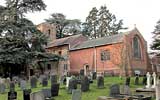 Edwalton Edwalton
Holy Rood
Stonework
The church is sited on mudstones of the Mercia Mudstone Group.
Description of the stones
The fabric of the church is quite a mixed bag of building materials. The tower
is principally brick with stone footings. These footings include orange-brown
coarsely crystalline, Bulwell Stone-type Magnesian Limestone, greenish-grey
fine-grained Skerry sandstone and ?relatively recent Carboniferous sandstone
inserts.
The west and east end walls of the south aisle consist of badly weathered,
reddish-brown, iron-rich Magnesian Limestone (similar stone to that seen at
Strelley Church).
The wall of the south aisle consists of a mixture of small, irregularly shaped,
greenish grey skerry sandstone on the west side of the porch, and larger squared
skerry blocks on the east side.
The lower portion of the Nave walls on the north side is of greenish-grey,
skerry sandstone. The upper part of the Nave walls N& S sides have been
raised with large blocks of pale pinkish-brown, cross-bedded sandstone. This
sandstone needs closer examination but probably came from the Triassic Sherwood
Sandstone. The nearest quarry source is possibly the old quarries at Castle
Donnington or Weston Cliffs.
Recent restoration work includes the insertion of red sandstone ashlar blocks
on the west end of the S. Aisle (?Hollington Stone (Triassic Sherwood Sandstone)
from Staffordshire) and on the eastern end blocks of Mansfield White dolomitic
sandstone of Permian age from Mansfield.
| 




